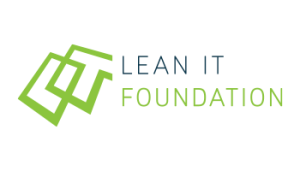Lean IT Foundation
Certificate: Lean IT Foundation
Duration: 2 days (virtual) classroom
Course Delivery: Classroom, Exam, eBook
Accreditor: Lean IT Association
Course ID: LIT-F
Language: English
PMI® PDUs: 16
Download a PDF of this course here.
Lean IT Foundation helps IT organizations to ensure that they provide their customers with the best possible services. Through understanding customer value, the processes that deliver this value, the way to manage performance, the way to organize and the required attitude and behavior, IT organizations are helped to develop a continuous improvement mindset. Lean IT is complementary to all other best practice methods (such as ITIL®, PRINCE2® and P3O®).
This course covers the Foundation level certification of the Lean IT Association. Further Lean IT qualifications are Lean IT Kaizen Lead, Lean IT Coach, and Lean IT Leadership. The Lean IT Foundation is the entry level certification. This certification is mandatory for the other certifications.
The primary purpose of the course is to provide a basis for accreditation of people involved with Lean IT Foundation. It documents the learning outcomes of the Lean IT Foundation and describes the requirements a candidate is expected to meet to demonstrate that these learning outcomes have been achieved.
Audience:
- Any manager or specialist working in an IT organization can benefit from the insights provided by the qualification.
- IT professionals who are participating in or involved with lean projects.
Learning Objectives:
Upon completion of the training and examination related to this qualification, a successful candidate will be familiar with the principles of the Lean philosophy and in particular with the application of this philosophy within an IT environment.
- The principles underlying the Lean philosophy
- The importance of understanding and delivering customer value
- The way Lean looks at processes and the waste within them
- How to measure performance and the key determinants of performance
- What the organizational requirements are when implementing Lean, including the use of visual management tools
- Which behavior and attitude is necessary for Lean to be successful within an IT organization
- The DMAIC problem-solving model
- How these Lean principles can be applied within an IT organization
Prerequisites:
There are no formal prerequisites for this course.
Course Material:
Participants will receive the following:
- A handbook/workbook (eBook) with reference materials, and an exam preparation guide.
- Lean IT Foundation Supporting Publication and Glossary
- Lean Primer Authors: Craig Larman and Bas Vodde
About the Examination:
- The exam is closed-book format.
- The exam consists of 50 multiple-choice questions.
- A minimum score of 75% is required to pass the exam.
- The exam lasts 60 minutes.
Technical Requirements:
For eBooks:
- Internet is required only for downloading the eBook. The eBooks can be read offline.
- eBooks can be downloaded and read on the following devices: Laptop, tablet, Smart Phone, eReader PDF Reader, recommended Adobe Reader.
Agenda:
| Day 1 | Day 2 |
| 1. Introduction of Lean
2. The Customer 3. The Process 4. Performance
|
1. The Lean Organization
2. Behavior and Attitude 3. Problem Solving 4. Wrap-up and Mock Exam 5. Exam |
Download a PDF of this course here.
COURSE OUTLINE
Module 1: Introduction
- Lean principles: how these are related to one another.
- Waste: ability to identify types of waste within an IT organization or process (TIMWOOD with Talent)
- The cost of poor quality and reasons for using Lean Principles to improve performance
- Types of activities: ability to define what IT activities fall into which category
- PDCA: ability to describe how the PDCA cycle works on the most basic level
- Relationship to other models and methods used within IT: understand where Lean IT differs from and complements other methods. The connection of Lean IT with IT service management is specifically investigated
Module 2: The Customer
- Types of customer value and the factors that influence customer value
- The link between the Voice of the Customer and Critical to Quality
- How to construct a Critical to Quality tree
Module 3: The Process
- Relationship of process (Value stream) with the other Lean principles
- The difference between Push and Pull systems
- The steps for creating a Value Stream Map, using SIPOC and Value Stream Map
- Waste in a Value Stream Map, ability to identify the symbols for the TIMWOOD waste
- Explain the SIPOC and VSM using IT examples e.g. SIPOC: Software development, VSM: High level Change process (other examples are permitted)
Module 4: Performance
- Relationship of performance with the PDCA cycle
- The key aspects of a KPI
- Why time is the most important production factor within IT
- The relationship of PCE with VSM
- The role of skills and knowledge in ensuring performance
Module 5: Organization
- Why organizations need to be customer oriented
- What the goal is of a performance dialogue
- The use of each of the visual management boards – day board, week board and Kaizen/improvement board
Module 6: Kaizen
- Which tools from the other dimensions are used in which phase of the DMAIC cycle
- Prioritization of improvement candidates through feasibility and impact in determining both which problems to solve with a Kaizen and which solutions to implement at the Improve step of the Kaizen
Module 7: Behavior & Attitude
- The difference between behavior and attitude
- The difference between traditional management and Lean management
- The behavior and attitude required for successful use of Lean Behavior and Attitude in relation to expectations surrounding a change in way of working

